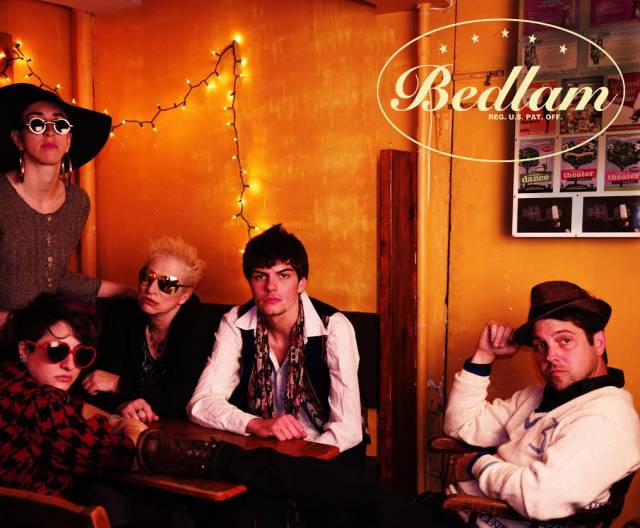
 New York Animals, a “play with music” produced by Manhattan’s Bedlam theatre company, takes a look at a collection of New York beasts of various stripes and spots—people whose lives intersect in sometimes predictable, sometimes unexpected ways. Tony-winning writer Steven Sater (Spring Awakening) devised the play and the lyrics, while the legendary Burt Bacharach composed the music for the show’s seven songs, which have not previously been recorded or performed publicly.
New York Animals, a “play with music” produced by Manhattan’s Bedlam theatre company, takes a look at a collection of New York beasts of various stripes and spots—people whose lives intersect in sometimes predictable, sometimes unexpected ways. Tony-winning writer Steven Sater (Spring Awakening) devised the play and the lyrics, while the legendary Burt Bacharach composed the music for the show’s seven songs, which have not previously been recorded or performed publicly.
Eric Tucker—Bedlam’s Artistic Director and co-founder (with Andrus Nichols)—recently spoke with StageBuddy about this production, which began previews in mid-November (it opens officially on November 29). Tucker notes that the collaboration between Sater and Bedlam began after the writer/lyricist saw—and admired—a pair of spring 2015 Bedlam productions of Shakespeare’s Twelfth Night, both of which were suffused with music. “He had this play that he’d written several years ago—New York Animals—and then, completely separately, he had songs that he had written with Burt Bacharach [namely, “trunk songs” from an earlier Sater/Bacharach collaboration]. And he wanted to combine the two—to figure out a way that he could weave the songs through the play.”
In the resulting production, four actors portray a total of 21 characters, including a well-heeled woman planning a dinner party (and riled up about missing parsnips); a surprisingly powerful cleaning lady; a gruff but sometimes amiable homeless man; a bulimic young mother-to-be; and a cab driver steeped in conspiracy theories. The play is set in 1995, but the characters are all more or less recognizable to 2015 audiences. Only the presence of corded phones and references to fax machines signal that the play is something of a period piece.
Animals (which Tucker describes as a work in progress) takes place in a cabaret-like setting. Audience members sit at tables with dimly lit lamps, and the actors (along with a five-piece band featuring lead singer Jo Lampert) perform around and among them. Says Tucker, who directed the production and plays six roles in it: “As you look around the space, everyone sees everyone. I felt like the play could exist in a room in which you’re not only looking at these characters from Steven’s New York, but [also at] a sea of other New Yorkers. In a way, the audience kind of becomes the set. They become the backdrop to the play, unwittingly.”

Tucker speaks highly of the collaboration with Sater, who, he says, has been fastidious about the finest details in his script. “At its best, when we get all of his rhythms—when we get all the little ‘yeahs’ and this and that—I think it can sound like we’re just making it up. Which is where it should be—it should sound like it’s coming from our own heads. But [Sater] is also not so precious that he won’t cut things or move things. He really is open to anything that will make the storytelling better or quicker when it needs to be. He’s really good about that—and it makes the [rehearsal] room so easy.”
While Sater was deeply engaged in the development of the project (which included rewrites of some lyrics, to make the songs work better in the context of the story), Bacharach has been essentially absent from the process. The composer gave Sater and Bedlam his blessing, and he plans to see the production at some point during its run. But that has been the extent of his involvement. Tucker and Sater have, however, had strong support from two other musical collaborators: vocal designer AnnMarie Milazzo and musical director (and pianist/vocalist) Debra Barsha.
There was talk during the first stages of the show’s development about what approach might be taken with Bacharach’s makeshift score. Should melodies by a composer so strongly associated with 1960s pop music be tweaked to have a 21st-century sound—or perhaps a sound reminiscent of 1995? Ultimately, it was decided that to attempt to divorce the songs from the trademark Bacharach style served no purpose. Instead, the ambitious Milazzo fashioned arrangements and vocal riffs that embrace what Tucker refers to as “Bacharach-ness.” The composer’s unmistakably nimble, popping sound, Tucker explains, has helped created a sort of “environmental bubble” in which to encase the world of the play.
Barsha, who is herself a theater composer (and currently an associate conductor for Broadway’s Jersey Boys), hadn’t originally planned to remain with Animals for its entire run but, according to Tucker, she fell in love with the show and decided to continue for the duration. “She embraces chaos,” he says. “She gets in there and we muck around in the material and switch it up and try things. Her energy is just boundless.”
What will happen with the property following Bedlam’s New York run is an open question at this point. The company has been interested in Sater’s musical adaptation of Arthur Schnitzler’s La Ronde (a play that, like Animals, explores the interconnectedness of disparate characters). There was originally talk of pairing the two works in repertory, and perhaps that could transpire somewhere down the line.
Tucker agrees that the prospect of hearing new Burt Bacharach songs in the context of a dramatic work has generated considerable interest in this project. Considering that the composer’s one-and-only Broadway book musical, Promises, Promises, debuted 47 years ago this December 1, it’s understandable that certain New York critters are more than ready for another dishful of theatrical Bacharach.
Performances of New York Animals continue through December 20.